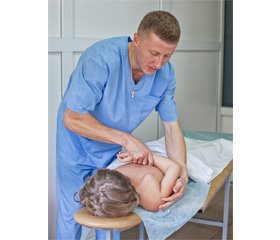Журнал «Травма» Том 15, №5, 2014
Вернуться к номеру
Efficiency of Immunocorrection in Treating Children with Initial Manifestation of Dysplastic Scoliosis
Авторы: Klimovitsky V.H., Donchenko L.I., Arar Thaer Jamal, Kravchenko A.I. - Research Institute of Traumatology and Orthopedics of Donetsk National Medical University named after M. Horkyi, Ukraine
Рубрики: Травматология и ортопедия
Разделы: Клинические исследования
Версия для печати
children, scoliosis, immune.
Introduction. Question the use of immunomodulators in the complex treatment of children with early manifestations of dysplastic scoliosis has not been widely publicized in the literature. Perhaps this is due to the complexity of the clinical and immunological studies of this group of children and thus a lack of information about the compensatory processes in the immune system in the early stages of the disease. This fact was one of the arguments necessary in-depth study of the immune response to different degrees of deformation of the spinal column. As shown by our own research, only at the initial manifestations of scoliosis occurs increased activity of the cellular link and nonspecific defense factors, as well as increased production of pro-inflammatory interleukins. which can be interpreted as a reaction of the immune system in the aseptic inflammation [1]. The results obtained allowed to prove the feasibility of immunotherapy in the early stages of the disease in order to stabilize the state [2].
The purpose of the work. On the basis of clinical and immunological studies to evaluate the effectiveness of the use of methods of immune complex in the treatment of children with dysplastic scoliosis I degree.
Materials and methods. In this paper, in a comparative perspective the results of treatment of 37 children aged 10–15 years from the initial manifestations of dysplastic scoliosis (spinal deformity did not exceed 200 po Cobb) were under observation in the clinic of orthopedics and traumatology for children NIITO Donetsk National Medical University. The diagnosis was verified by clinical-radiological examination. Radiographic studies included the standard projection of the spine. All children selected groups conducted clinical and laboratory studies of the immune system, both before and after 3–4 months after treatment. Of the total number of children surveyed identified two groups. The study group included 18 children in the complex treatment, which used the methods of immune (group 1). The control group consisted of 19 children who received conventional treatment (group 2).
Immunotherapy was the use in the complex treatment of children of the study group Immunopreparat stimulating cellular immunity (preparations of echinacea, limfomiozot et al.), Multivitamins containing macro-and micronutrients, as well as hepatic and antioxidants.
The results of the study. A comparative characterization of children study and control groups revealed no statistically significant differences between groups by age and sex.
Analysis of the immune system in children in both groups before treatment is also not statistically significant razdichy established between the studied parameters, indicating the possibility of correctness and comparing them. It should be noted that the immune status of children in both groups showed an increase in phagocytic activity of neutrophils in the background of normal performance of their microbicidal activity and increased relative to the reference values of the content in the peripheral blood T-helper cells and circulating immune complexes. In previous publications [1], we give a detailed assessment of the response of the immune system in the initial manifestations of dysplastic scoliosis, which was the rationale for the use of immunomodulators in the complex treatment.
The use of immunotherapy in the complex treatment of children with early manifestations of dysplastic scoliosis contributed to prolongation of compensatory reactions of the immune system. Thus, a comparative analysis of the immune system before treatment and after 3-4 months after treatment revealed that the children of the study group the number of T-lymphocytes and their regulatory subpopulations of T-helper cells was higher than that of children treated conventionally (Table 2). No significant changes in the content of T-suppressors in children both groups contributed to higher immunoregulatory index of children in the study group compared with the control group. There were also differences in the activity of phagocytosis in children after treatment. Thus, in the study group of children the phagocytic activity of neutrophils was higher, and their microbicidal activity (NBT-test) lower than the control group. In contrast, the control group changes in the immune system that are characterized by a decrease in the phagocytic activity of neutrophils against increase their microbicidal activity, showed the prevalence of oxidative processes in the phagocytosis. A statistically significant increase in the level of circulating immune complexes in the blood serum of children in the control group after treatment. In contrast, those found in the group of children studied groups were not significantly different from that of before treatment (Table 2). The study revealed the relationship between the activity of the cell-level and degree of progression of scoliosis. It has been established that children with elevated cellular level of the immune system disease progression is not as pronounced as in children with indicators of immunity, is not different from the reference values.
The application of this method of treatment has improved the results of treatment, receiving state stabilization without further increasing the amount of deformation at 63.4 % of the observed children of the study group. In the group of children in the control group this figure was 43.7 %.
Conclusions. The results obtained suggest that the use of immunomdulyatorov, hepatic and antioxidants in komples treatment of children with spinal deformity and 200 promotes activation of lymphoid link the immune system and nonspecific defense factors. Thus, at the system level are prerequisites for the extension of compensatory processes inherent in the initial manifestations of dysplastic scoliosis, which can be considered as a positive factor in terms of the disease.

